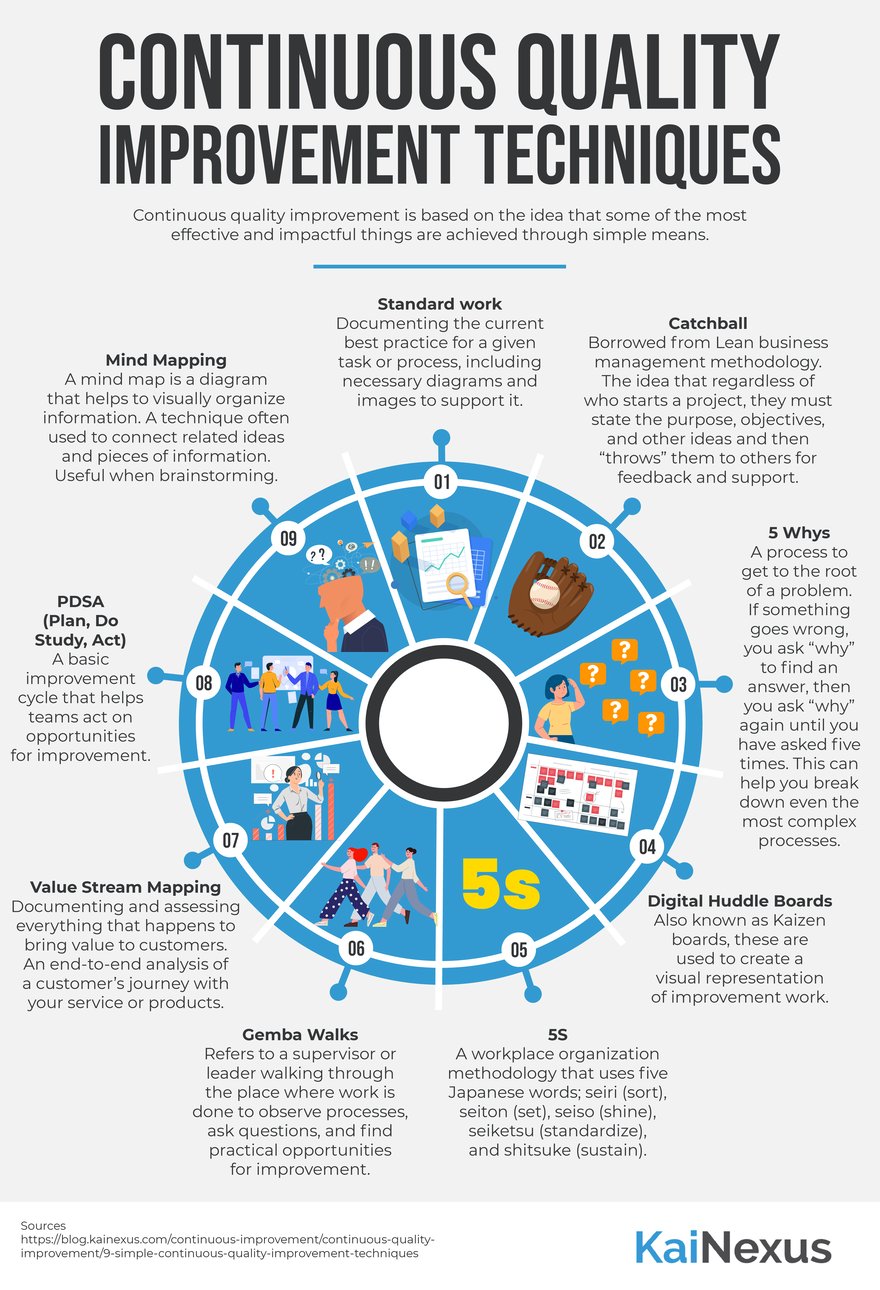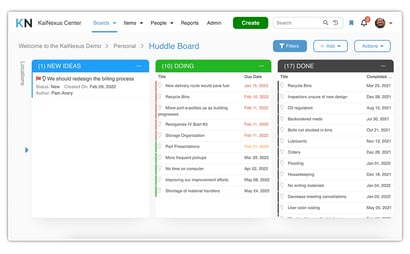Methods to Achieve the Goals of Continuous Quality Improvement
When it comes to continuous quality improvement, this is absolutely the case. Here are 9 examples of quality improvement tools, techniques, and technology that are uncomplicated yet extremely valuable. Standard work is simply the documentation of the current best practice for any given task or process. That's it. It should be detailed and include any necessary supporting assets like diagrams or images. It needs to be accessible to everyone performing the work and is ideally designed by those involved. There's nothing tricky about it, but it is the key to continuous quality improvement. You just can't improve something that has no baseline from which to improve. The idea of Catchball comes from the Lean business management methodology. The idea is that no matter who starts a project, that person (often, but not always a manager) states the purpose, objectives, other ideas, and concerns, and then 'throws' them to others for feedback, ideas, support, and action. This creates a bi-directional loop, which shows clear ownership and accountability. Everyone knows who has the "ball" so to speak. The 5 Whys is a process getting to the root cause of any problem. When something goes wrong, you ask "why." That answer leads to another "why" and so forth. It turns out that the underlying cause of most process breakdowns can be uncovered by asking why about 5 times. Huddle boards (also called Kaizen boards) are used to create a visual representation of improvement work. This helps people easily understand the health of continuous quality improvement within the organization and immediately detect when progress on any given project is stalled. In modern practice, they are electronic so they can be accessed from anywhere by any member of the team. 5S is a workplace organization method that uses a list of five Japanese words: (sort), (set), (shine), (standardize), and (sustain). An organized workplace is the key to efficiency and safety. It can also be enormously important when attempting to reduce waste, especially the wastes of motion and transportation. During a Gemba Walk, a supervisor or other leader goes to the place where the work is done to observe and ask questions of the people doing the work. The goal is not to evaluate people's performance, but rather to seek opportunities for improvement and get a clear understanding of how the standard work is being executed in the real world. After the walk, the supervisor may use Catchball or another technique to begin the process of improvement. Value Stream Mapping is a way of documenting and assessing everything that happens to bring value to the customer. It is an end-to-end analysis of how a service or product goes from the initial requires into the hands of the customer. Processes that add value are improved, while those that don't add value are eliminated. It is an excellent method for uncovering the current state and a jumping off point for quality improvement and waste reduction. PDSA stands for Plan, Do, Study, Act. It is a basic improvement cycle that helps teams act on opportunities for improvement. The planning phase involves understanding the current state of affairs and describing the desired state. During the "Do" step, potential improvements are introduced. This is followed by a period in which the results are studied. Finally, if the changes are positive, the standard work is updated, and the new process is enacted. A mind map is a diagram used to visually organize information. It is a technique for visualizing connections between many related ideas or pieces of information. It can be extremely useful in brainstorming, problem-solving, project planning, and note-taking. Mind maps are like a tree, starting with a core thought (the trunk) and connecting it to related ideas, big (branches) and small (twigs). The visual structure makes gaps in knowledge readily apparent and relationships between ideas clear. It is useful anytime fresh thinking is needed and is effective for process development, product improvement, quality control, or any other opportunity for improvement. These techniques are all very straightforward, but the key is in the execution. When they are applied thoughtfully, they can be extremely powerful and produce the incremental daily improvement for which most organizations strive. I often find myself falling into the common trap of believing that if something is worthwhile, it is necessarily difficult. I think we all expect that valuable things are hard. The truth is, however, that sometimes the most effective and impactful things we can do are really quite simple.
I often find myself falling into the common trap of believing that if something is worthwhile, it is necessarily difficult. I think we all expect that valuable things are hard. The truth is, however, that sometimes the most effective and impactful things we can do are really quite simple.

1. Standard Work

2. Catchball
3. The 5 Whys

4. Digital Huddle Boards
5. 5S
6. Gemba Walks
7. Value Stream Mapping
8. PDSA

9. Mind Mapping
Topics: Quality, Spread Continuous Improvement
Source: https://blog.kainexus.com/continuous-improvement/continuous-quality-improvement/9-simple-continuous-quality-improvement-techniques
0 Response to "Methods to Achieve the Goals of Continuous Quality Improvement"
Post a Comment